PROJECT
TECHNOLOGIES


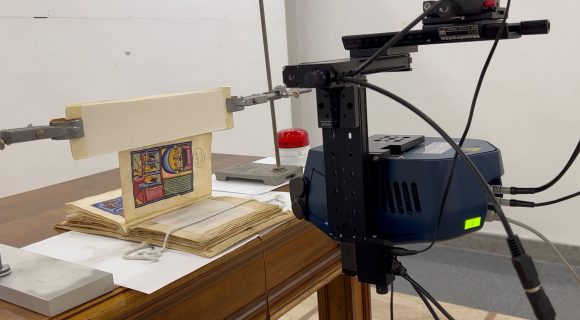
Portable X-ray fluorescence spectrometer (pXRF)
This Bruker ELIO instrument provides for non-invasive and non-destructive measurements, without contact and without preparation of the material to be investigated.
The measuring head (W x D x H: 170 mm x 265 mm x 170 mm), weighs approximately 2 kg and is housed on an XY motorised stage system fixed on a tripod. The system can record point spectra and/or it can map areas up to a maximum size of 10 mm x 10 mm, which allows the distribution of several elements at once.
There are two lasers that enable the correct alignment of the source and detector by positioning the measuring head at the correct distance from the surface to be investigated. It also has an internal camera (with a 10 mm x 10 mm field of view) that can record a high-resolution image of the measurement point.
The Elio dedicated Esprit Reveal software supports the reprocessing of the acquired spectra and maps.

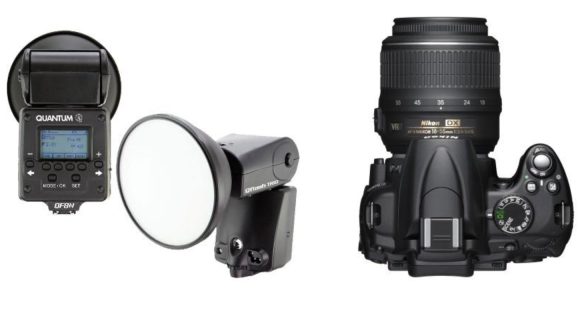
Photography camera for luminescence induced by ultraviolet radiation (UVL)
Canon EOS 7D digital camera (18 Mpixel, CMOS sensor)
Canon EOS 450D camera (12 Mpixel, CMOS sensor) modified by the removal of the internal filter
Quantum flash model Qflash T5dR (150W/s) for the lighting on which the various filters are mounted. Filters for use on the flashes and lens: Schneider Optic B+W 403 UV Black, Schneider Optics B+W Infrared IR 093, Schneider Optics B+W Infrared B+W 486 UV/IR blocking
The techniques that can be applied are:
- visible in scattered light (LV)
- ultraviolet fluorescence (UVL)
- reflected ultraviolet (UVR)
- near-infrared (IR)
From the combinations of visible imaging with reflected UV and near-IR, one can obtain ultraviolet false colour (UVfc) and infrared false colour (IRfc) images respectively.


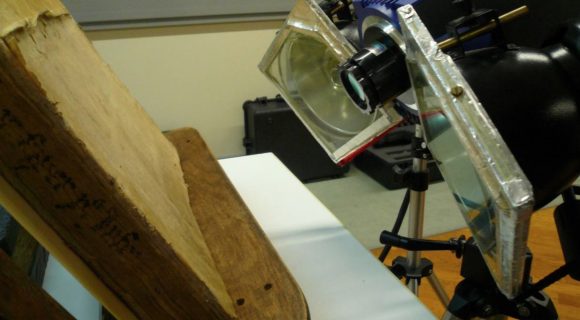
Thermal imaging infrared camera
The mid-infrared camera used is a device with an optical system for collecting infrared radiation, a sensor array for point measurement of the radiation emitted by the sample and, finally, an electronic system for reading and collecting the output signals produced by the individual sensors. This model is a CEDIP Jade MWIR camera, with a 3.5-5.1 μm spectral range, which has the following characteristics: 320 × 240 pixel InSb focal plane array, with a pixel pitch of 30 μm. The image sequences are then processed using Altair 5.50 software. The camera and software can also be used for reflectographic image acquisition.

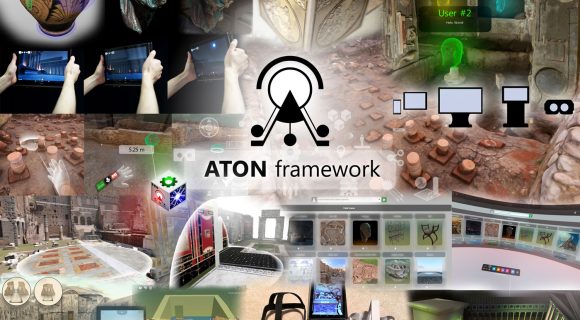
ATON
The ATON open-source framework, (GPL v3 licence), based on Node.js and Three.js, has been designed to create Web3D/WebXR applications. It is the result of research and development carried out in recent years by CNR ISPC. The ATON instrument is scalable, flexible and modular; it enables the creation and deployment of ‘liquid’ web applications that can be viewed on a wide range of devices (from mobile to immersive VR viewers) and it requires no installation by end users. It provides innovative and advanced functionalities for the Cultural Heritage sector in terms of 3D presentation, interaction models, annotation, immersive use and real-time collaboration.

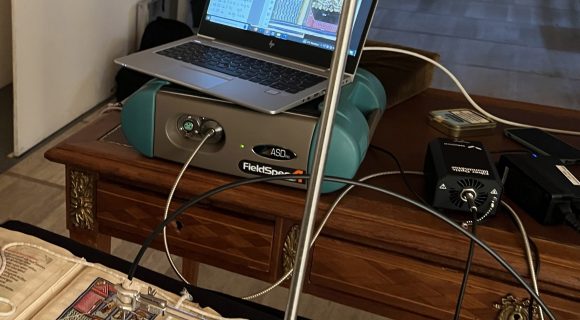
Malvern Panalytical ASD FieldSpec® 4 Hi-Res Spectrometer (350-2500nm)
This instrument has three detectors: a 512-element silicon array covering the 350-1000 nm spectral range, and two InGaAs photodiodes for the 1000-1800 nm and the 1800-2500 nm spectral ranges. The instrument’s spectral resolution is 3 nm in the VNIR range (350-1000 nm) and 10 nm in the SWIR range (1000-2500 nm). A complete spectrum can be acquired in 0.1 seconds. The instrument is equipped with a 1 m long optical fibre directly connected to the spectrophotometer with a 25° FOV. Using an external illumination consisting of a 12V quartz-tungsten lamp with ventilated cooling (placed at 45° to the surface) and the permanent fibre (placed perpendicular to the surface), measurements can be made with CIE 45/0 geometry. The lateral resolution in this set-up is dictated by the working distance. Indicatively, the measurement area is approximately one half the working distance. Alternatively, the instrument is equipped with two bifurcated fibre-optic systems (large- and small-diameter), which can be connected to the permanent fibre and an external source with a nominal power of 12V DC at 30 W. The SpectralonTM is used for white calibration. The RS3 Software Package is used for data acquisition.

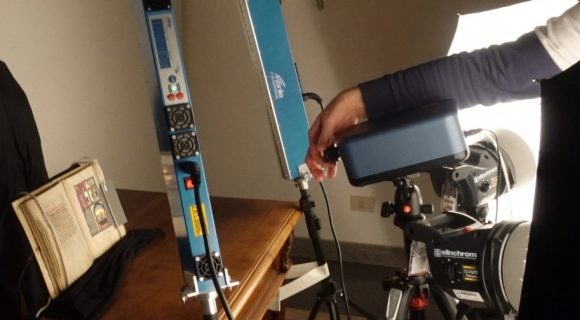
Portable hyper-spectral imaging system in the visible spectral range (VIS)
This SOC710 hyper-spectral imaging system consists of a high-precision camera using a low-noise, high-speed silicon-based CCD as a spectrometer in the 400-1000 nm range. The system features an integrated scanning system as well as image collection and analysis software. The SOC710 can record hyper-spectral images at a rate of 4 megabytes of data per second (128 band elements per second at 12-bit resolution, 520 pixels per line, and up to 33 lines per second). In order to obtain well-defined reflectance spectra over the entire spectral range, photographic halogen lamps are normally used as light sources. Nevertheless, the instrument can also be used in ambient light conditions by appropriately adjusting exposure times and signal integration. To obtain the hyper-spectral fluorescence images, the surface to be examined should be illuminated with monochromatic LEDs emitting at 405 nm.
